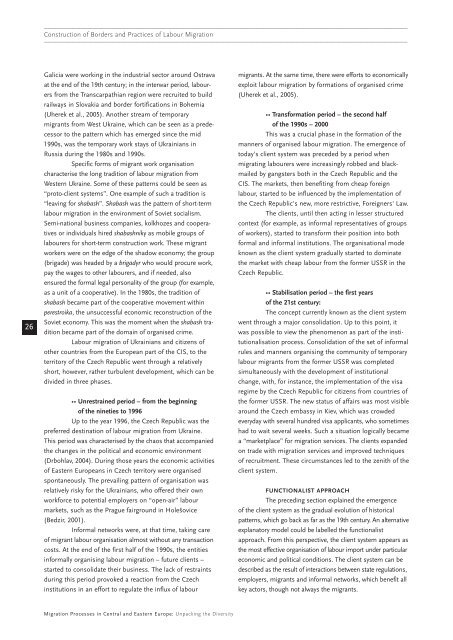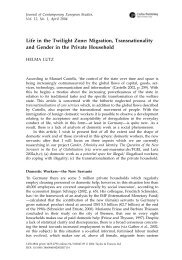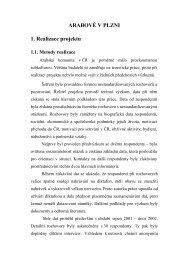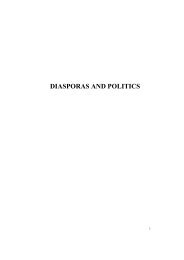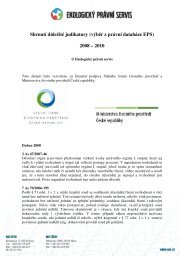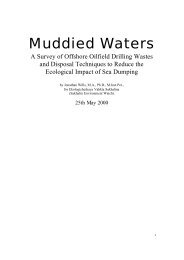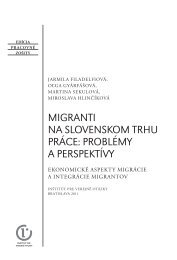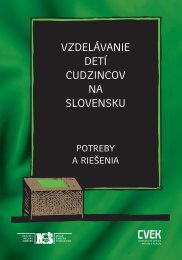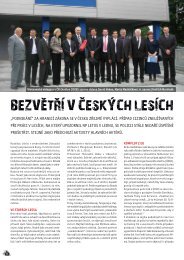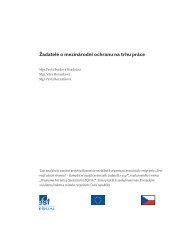Migration Processes in Central and Eastern Europe - Multiple Choices
Migration Processes in Central and Eastern Europe - Multiple Choices
Migration Processes in Central and Eastern Europe - Multiple Choices
You also want an ePaper? Increase the reach of your titles
YUMPU automatically turns print PDFs into web optimized ePapers that Google loves.
———————————————————————————————————————————————————————————————<br />
Construction of Borders <strong>and</strong> Practices of Labour <strong>Migration</strong><br />
———————————————————————————————————————————————————————————————<br />
26<br />
Galicia were work<strong>in</strong>g <strong>in</strong> the <strong>in</strong>dustrial sector around Ostrava<br />
at the end of the 19th century; <strong>in</strong> the <strong>in</strong>terwar period, labourers<br />
from the Transcarpathian region were recruited to build<br />
railways <strong>in</strong> Slovakia <strong>and</strong> border fortifications <strong>in</strong> Bohemia<br />
(Uherek et al., 2005). Another stream of temporary<br />
migrants from West Ukra<strong>in</strong>e, which can be seen as a predecessor<br />
to the pattern which has emerged s<strong>in</strong>ce the mid<br />
1990s, was the temporary work stays of Ukra<strong>in</strong>ians <strong>in</strong><br />
Russia dur<strong>in</strong>g the 1980s <strong>and</strong> 1990s.<br />
Specific forms of migrant work organisation<br />
characterise the long tradition of labour migration from<br />
Western Ukra<strong>in</strong>e. Some of these patterns could be seen as<br />
“proto-client systems”. One example of such a tradition is<br />
“leav<strong>in</strong>g for shabash”. Shabash was the pattern of short-term<br />
labour migration <strong>in</strong> the environment of Soviet socialism.<br />
Semi-national bus<strong>in</strong>ess companies, kolkhozes <strong>and</strong> cooperatives<br />
or <strong>in</strong>dividuals hired shabashniky as mobile groups of<br />
labourers for short-term construction work. These migrant<br />
workers were on the edge of the shadow economy; the group<br />
(brigade) was headed by a brigadyr who would procure work,<br />
pay the wages to other labourers, <strong>and</strong> if needed, also<br />
ensured the formal legal personality of the group (for example,<br />
as a unit of a cooperative). In the 1980s, the tradition of<br />
shabash became part of the cooperative movement with<strong>in</strong><br />
perestroika, the unsuccessful economic reconstruction of the<br />
Soviet economy. This was the moment when the shabash tradition<br />
became part of the doma<strong>in</strong> of organised crime.<br />
Labour migration of Ukra<strong>in</strong>ians <strong>and</strong> citizens of<br />
other countries from the <strong>Europe</strong>an part of the CIS, to the<br />
territory of the Czech Republic went through a relatively<br />
short, however, rather turbulent development, which can be<br />
divided <strong>in</strong> three phases.<br />
•• Unrestra<strong>in</strong>ed period – from the beg<strong>in</strong>n<strong>in</strong>g<br />
of the n<strong>in</strong>eties to 1996<br />
Up to the year 1996, the Czech Republic was the<br />
preferred dest<strong>in</strong>ation of labour migration from Ukra<strong>in</strong>e.<br />
This period was characterised by the chaos that accompanied<br />
the changes <strong>in</strong> the political <strong>and</strong> economic environment<br />
(Drbohlav, 2004). Dur<strong>in</strong>g those years the economic activities<br />
of <strong>Eastern</strong> <strong>Europe</strong>ans <strong>in</strong> Czech territory were organised<br />
spontaneously. The prevail<strong>in</strong>g pattern of organisation was<br />
relatively risky for the Ukra<strong>in</strong>ians, who offered their own<br />
workforce to potential employers on “open-air” labour<br />
markets, such as the Prague fairground <strong>in</strong> Holešovice<br />
(Bedzir, 2001).<br />
Informal networks were, at that time, tak<strong>in</strong>g care<br />
of migrant labour organisation almost without any transaction<br />
costs. At the end of the first half of the 1990s, the entities<br />
<strong>in</strong>formally organis<strong>in</strong>g labour migration – future clients –<br />
started to consolidate their bus<strong>in</strong>ess. The lack of restra<strong>in</strong>ts<br />
dur<strong>in</strong>g this period provoked a reaction from the Czech<br />
<strong>in</strong>stitutions <strong>in</strong> an effort to regulate the <strong>in</strong>flux of labour<br />
migrants. At the same time, there were efforts to economically<br />
exploit labour migration by formations of organised crime<br />
(Uherek et al., 2005).<br />
•• Transformation period – the second half<br />
of the 1990s – 2000<br />
This was a crucial phase <strong>in</strong> the formation of the<br />
manners of organised labour migration. The emergence of<br />
today's client system was preceded by a period when<br />
migrat<strong>in</strong>g labourers were <strong>in</strong>creas<strong>in</strong>gly robbed <strong>and</strong> blackmailed<br />
by gangsters both <strong>in</strong> the Czech Republic <strong>and</strong> the<br />
CIS. The markets, then benefit<strong>in</strong>g from cheap foreign<br />
labour, started to be <strong>in</strong>fluenced by the implementation of<br />
the Czech Republic's new, more restrictive, Foreigners' Law.<br />
The clients, until then act<strong>in</strong>g <strong>in</strong> lesser structured<br />
context (for example, as <strong>in</strong>formal representatives of groups<br />
of workers), started to transform their position <strong>in</strong>to both<br />
formal <strong>and</strong> <strong>in</strong>formal <strong>in</strong>stitutions. The organisational mode<br />
known as the client system gradually started to dom<strong>in</strong>ate<br />
the market with cheap labour from the former USSR <strong>in</strong> the<br />
Czech Republic.<br />
•• Stabilisation period – the first years<br />
of the 21st century:<br />
The concept currently known as the client system<br />
went through a major consolidation. Up to this po<strong>in</strong>t, it<br />
was possible to view the phenomenon as part of the <strong>in</strong>stitutionalisation<br />
process. Consolidation of the set of <strong>in</strong>formal<br />
rules <strong>and</strong> manners organis<strong>in</strong>g the community of temporary<br />
labour migrants from the former USSR was completed<br />
simultaneously with the development of <strong>in</strong>stitutional<br />
change, with, for <strong>in</strong>stance, the implementation of the visa<br />
regime by the Czech Republic for citizens from countries of<br />
the former USSR. The new status of affairs was most visible<br />
around the Czech embassy <strong>in</strong> Kiev, which was crowded<br />
everyday with several hundred visa applicants, who sometimes<br />
had to wait several weeks. Such a situation logically became<br />
a “marketplace” for migration services. The clients exp<strong>and</strong>ed<br />
on trade with migration services <strong>and</strong> improved techniques<br />
of recruitment. These circumstances led to the zenith of the<br />
client system.<br />
FUNCTIONALIST APPROACH<br />
The preced<strong>in</strong>g section expla<strong>in</strong>ed the emergence<br />
of the client system as the gradual evolution of historical<br />
patterns, which go back as far as the 19th century. An alternative<br />
explanatory model could be labelled the functionalist<br />
approach. From this perspective, the client system appears as<br />
the most effective organisation of labour import under particular<br />
economic <strong>and</strong> political conditions. The client system can be<br />
described as the result of <strong>in</strong>teractions between state regulations,<br />
employers, migrants <strong>and</strong> <strong>in</strong>formal networks, which benefit all<br />
key actors, though not always the migrants.<br />
<strong>Migration</strong> <strong>Processes</strong> <strong>in</strong> <strong>Central</strong> <strong>and</strong> <strong>Eastern</strong> <strong>Europe</strong>: Unpack<strong>in</strong>g the Diversity


